All told, there are about 170 outdoor sculptures around Portland and Multnomah County. About a half dozen were badly damaged this year.
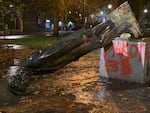
Protesters in Portland toppled multiple statues, including this one of President Abraham Lincoln, on Sunday, Oct. 11, 2020, during an event they called "Indigenous People's Day of Rage."
Sergio Olmos
“It was concentrated in downtown, and it was a result of very justified protests,” said Keith Lachowicz, the public arts manager with the Regional Arts and Culture Council. The RACC maintains the city’s public art, and it’s Lachowicz’s job to figure out how to repair statues and what to do with them.
Take statues of former Presidents Abraham Lincoln and Theodore Roosevelt on the South Park Blocks. They were damaged in a demonstration in October against colonization and the historic mistreatment of Native populations.
The Lincoln statue is in good shape. The Roosevelt statue is not.
“The Teddy Roosevelt piece fell from a pretty high height and came over with a 10,000-pound piece of granite attached to it,” Lachowicz said. “The impact to the side of it is pretty significant.”
Repairs, if they are ever done, will not be cheap.
“Pieces like that need to be sort of stood up, a cradle needs to be built. We have to have a room that’s big enough, with a lifting mechanism,” he said. “You need a forklift or a crane.
“That assessment process has not been done yet, and that will take many many months, if not into years.”
Statues of founding fathers who were slaveholders have been criticized and questioned in Oregon and across the country this year. A statue of Thomas Jefferson was pulled down in July, outside Jefferson High School in North Portland. George Washington’s statue in Northeast Portland was pulled down on Juneteenth.
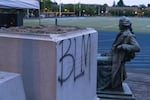
The Thomas Jefferson statue sits next to its at Jefferson High School in Northeast Portland after protesters tore it down after a Black Lives Matter rally.
Jonathan Levinson / OPB
Another statue called The Promised Land depicted a pioneer family and was targeted as a symbol of colonialism.
The city has its hands full at the moment with COVID-19 and protests. But when things calm down, city leaders and the arts council have big, hard questions to answer: Should these symbols be left in storage, put back up, placed in a museum, or something else?
“It’s going to be tough to have a conversation about something that currently is so fraught,” said Shirley Jackson, a Black Studies professor at Portland State University. She’s in favor of a public discussion but thinks it should involve more than statues. She wants a community conversation that includes the names on some buildings and even institutions, such as Lewis & Clark College.
Indeed, Portland Public Schools leaders are already planning to rename Wilson High School after a Black woman. It was named for President Woodrow Wilson, who segregated federal offices and wrote a book sympathetic to the Ku Klux Klan.
“There is a reckoning that is happening … where there is greater scrutiny about the actions of individuals,” Jackson said.
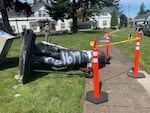
A statue of George Washington was pulled down from the lawn outside the German American Society in Northeast Portland on June 18, 2020.
Rebecca Ellis/OPB
She warned that some people won’t participate in any discussion, because whatever they’ve had to say in the past hasn’t been heard. And she worries that civic leaders will attempt to correct the mistakes of the past with gestures that are more symbolic than true cultural and systemic change.
“I can see there being a suggestion that there be murals by black artists ... as though that is all BIPOC people have to offer,” Jackson said. “I think there has to be some really serious conversation about whether or not we really need to have statues.
“What else might take the place of a statue?”
Portland Commissioner Chloe Eudaly issued a statement in October saying it’s past time to consider the meaning, impact and future of public art: “We should all have the opportunity to discuss what these statues mean to us and our communities and decide what deaccessioning based on justice and reconciliation should look like.”
But there are some statues for which it’s hard to ascribe a political reason for damage, such as the large elk on Southwest 5th Avenue downtown.
The statue, formally known as the David P. Thompson Fountain, was donated by a former Portland mayor in 1900 and is simply an elk standing on top of a water fountain. It was damaged by demonstrators lighting fires in the stone trough earlier this year.
“How can you make an elk politicized? They certainly found a way to do it,” said Jeremy FiveCrows, a Nez Perce tribal member who has lived in Portland for 25 years. He said he appreciated the elk, precisely because it championed nature rather than a person.
“Everybody has flaws … it can be so fraught. Whereas that natural environment, our amazing wildlife, is something that we can all identify with,” FiveCrows said.
The elk may have just been in the wrong place at the wrong time during this summer’s protests against police violence and for racial justice, standing as it does between the Justice Center, City Hall and the federal courthouse.
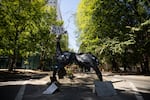
A makeshift elk statue stands between Chapman and Lownsdale squares Aug. 30, 2020, in Portland, Ore. The city removed the previous elk statue weeks prior amid nightly protests.
Bradley W. Parks / OPB
But the imagery has taken on a life of its own. Someone built another elk to put in its place., dubbed by someone the “nightmare elk.” It was covered in protest statements and proudly displayed. Then that elk was taken by supporters of President Donald Trump, painted with Trump 2020 and displayed at a rally in Salem.
Meanwhile, it’s unclear what will happen to Portland’s original elk. According to the arts council, repairs could cost hundreds of thousands of dollars.
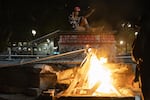
A protester sits where an elk statue used to stand during protests against racism and police violence in Portland, Ore., on July 16, 2020.
Jonathan Levinson / OPB


